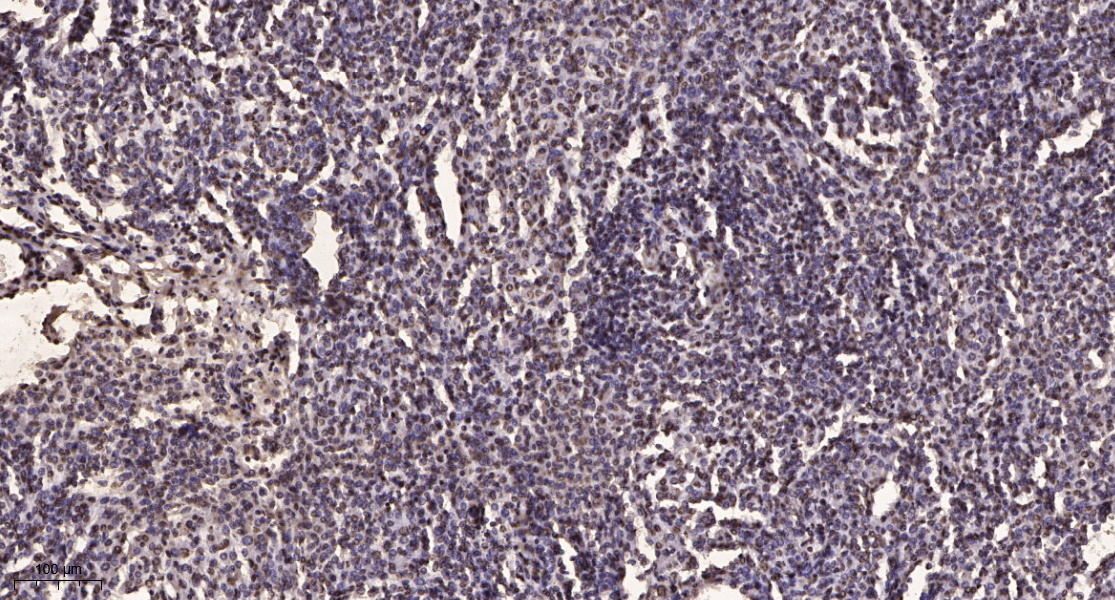产品名称
Smad2/3 (Acetyl-Lys19) Rabbit Polyclonal Antibody
基因名称
Smad2/3 (Acetyl-Lys19)
蛋白名称
Smad2/3 (Acetyl-Lys19)
存储缓冲液
Liquid in PBS containing 50% glycerol, 0.5% BSA and 0.02% New type preservative N.
Human Swissprot No.
Q15796/P84022
Human Swissprot Link
https://www.uniprot.org/uniprotkb/Q15796/entry
Rat Swissprot Link
Human:K19, Mouse:K19, Rat:K19
免疫原
Synthesized peptide derived from human Smad2/3 (Acetyl-Lys19)
特异性
This antibody detects endogenous acetyl levels of Smad2/3 (Acetyl-Lys19) at Human:K19, Mouse:K19, Rat:K19
稀释度
IHC-p 1:50-200, WB 1:500-2000. IF 1:50-200
宿主
Polyclonal, Rabbit,IgG
背景介绍
The protein encoded by this gene belongs to the SMAD, a family of proteins similar to the gene products of the Drosophila gene 'mothers against decapentaplegic' (Mad) and the C. elegans gene Sma. SMAD proteins are signal transducers and transcriptional modulators that mediate multiple signaling pathways. This protein mediates the signal of the transforming growth factor (TGF)-beta, and thus regulates multiple cellular processes, such as cell proliferation, apoptosis, and differentiation. This protein is recruited to the TGF-beta receptors through its interaction with the SMAD anchor for receptor activation (SARA) protein. In response to TGF-beta signal, this protein is phosphorylated by the TGF-beta receptors. The phosphorylation induces the dissociation of this protein with SARA and the association with the family member SMAD4. The association with SMAD4 is important for the translocation
组织表达
Expressed at high levels in skeletal muscle, endothelial cells, heart and placenta.
细胞定位
Cytoplasm . Nucleus . Cytoplasmic and nuclear in the absence of TGF-beta. On TGF-beta stimulation, migrates to the nucleus when complexed with SMAD4 (PubMed:9865696, PubMed:21145499). On dephosphorylation by phosphatase PPM1A, released from the SMAD2/SMAD4 complex, and exported out of the nucleus by interaction with RANBP1 (PubMed:16751101, PubMed:19289081). Localized mainly to the nucleus in the early stages of embryo development with expression becoming evident in the cytoplasm at the blastocyst and epiblast stages (By similarity). .
功能
disease:Defects in SMAD2 are found in sporadic cases of colorectal carcinoma.,function:Transcriptional modulator activated by TGF-beta and activin type 1 receptor kinase. SMAD2 is a receptor-regulated SMAD (R-SMAD). May act as a tumor suppressor in colorectal carcinoma.,PTM:Acetylated on Lys-19 by coactivators in response to TGF-beta signaling, which increases transcriptional activity. Isoform short: Acetylation increases DNA binding activity in vitro and enhances its association with target promoters in vivo.,PTM:In response to TGF-beta, ubiquitinated by NEDD4L; which promotes its degradation.,PTM:Phosphorylated on one or several of Thr-220, Ser-245, Ser-250, and Ser-255. In response to TGF-beta, phosphorylated on Ser-465/467 by TGF-beta and activin type 1 receptor kinases. Able to interact with SMURF2 when phosphorylated on Ser-465/467, recruiting other proteins, such as SNON, for degradation. In response to decorin, the naturally occurring inhibitor of TGF-beta signaling, phosphorylated on Ser-240 by CaMK2. Phosphorylated by MAPK3 upon EGF stimulation; which increases transcriptional activity and stability, and is blocked by calmodulin.,similarity:Belongs to the dwarfin/SMAD family.,similarity:Contains 1 MH1 (MAD homology 1) domain.,similarity:Contains 1 MH2 (MAD homology 2) domain.,subcellular location:Cytoplasmic in the absence of ligand. Migrates to the nucleus when complexed with SMAD4.,subunit:Found in a complex with SMAD3 and TRIM33 upon addition of TGF-beta. Interacts with SMAD3 and TRIM33. Interacts with SARA (SMAD anchor for receptor activation); may form trimers with the SMAD4 co-SMAD. Interacts with FOXH1, homeobox protein TGIF, PEBP2-alpha subunit, CREB-binding protein (CBP), EP300 and SKI. Interacts with SNON; when phosphorylated at Ser-465/467. Interacts (via PY-motif) with SMURF2. Interacts with AIP1 and HGS. Interacts with NEDD4L in response to TGF-beta (By similarity). Interacts with LBXCOR1 and CORL2.,tissue specificity:Expressed at high levels in skeletal muscle, heart and placenta.,
纯化
The antibody was affinity-purified from rabbit serum by affinity-chromatography using specific immunogen.

